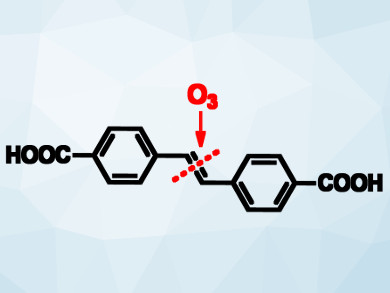Metal−organic frameworks (MOFs) are microporous materials composed of organic ligands and metal centers. They are useful, e.g., for gas storage and separation. Creating larger mesopores instead of micropores in MOFs is challenging, but could be useful to allow the encapsulation of large molecules or to improve the material’s storage capacity.
Inhar Imaz, The Barcelona Institute of Science and Technology, Spain, Daniel Maspoch, The Barcelona Institute of Science and Technology and Catalan Institution for Research and Advanced Studies (ICREA), Barcelona, Spain, and colleagues have developed a method for the postsynthetic creation of mesopores in a MOF. The team designed Zr-MOFs by combining ZrCl4 with two types of ligands: one with a double bond that can be cleaved by ozonolysis (example pictured) and one without. The two ligands are both dicarboxylic acids with very similar lengths and shapes, thus, they act similar during the synthesis of the MOF.
After the MOF is synthesized, the ligand with the double bond can be selectively cleaved by dispersing the material in dimethylformamide (DMF) and subjecting the mixture to an ozone flux. The ligand without a double bond is unaffected. This introduces defects in the MOF’s structure and creates mesopores, while the material remains crystalline. After the ozonolysis, the pore volume of the MOF had risen significantly.
- Postsynthetic Selective Ligand Cleavage by Solid–Gas Phase Ozonolysis Fuses Micropores into Mesopores in Metal–Organic Frameworks,
Vincent Guillerm, Heng Xu, Jorge Albalad, Inhar Imaz, Daniel Maspoch,
J. Am. Chem. Soc. 2018.
https://doi.org/10.1021/jacs.8b09682



![Synthesis of [c2]Daisy Chains via Mechanochemistry](https://www.chemistryviews.org/wp-content/uploads/2025/04/202504_RotaxanesWithSolidStateMechanochemistry-125x94.png)
